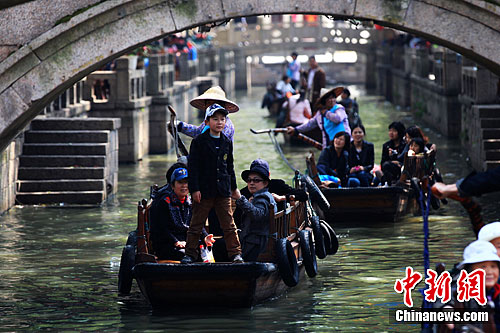
During the traditional Tomb Sweeping Day holiday in early April, many people discovered that the cost of admission to various national-level scenic spots had been pushed up by at least 20 percent.
(Ecns.cn) -- Exorbitant admission fees are already a common complaint from tourists in China, yet bitter criticisms will likely burst out again as a number of domestic tourist attractions are expected to increase ticket prices before the peak travel season, reports the Economic Information Daily.
A regulation introduced by the National Development and Reform Commission (NDRC) in 2007 limits the frequency of ticket price changes to once every three years for national tourist attractions. The year 2012 marks the second window after three years for ticket price adjustments, and no one expects prices to do anything but go up.
According to the Economic Information Daily, more than 20 tourist attractions will announce price rises of between 20 to 60 percent for entry in the next few months.
Tourists fall prey
During the traditional Tomb Sweeping Day holiday in early April, many people discovered that the cost of admission to various national-level scenic spots had been pushed up by at least 20 percent.
Tickets to the Jinggangshan Scenic Spot in Jiangxi Province were raised from 130 yuan (US$20.6) to 160 yuan (US$25.4) on March 31, while the entry fee to the Taierzhuang Ancient City in Shandong Province was increased from 100 yuan (US$15.9) to 160 yuan (US$25.4) on April 1, according to the Beijing News.
Other national-level tourist attractions are only waiting for their opportunity, and they will also inevitably apply to raise ticket prices.
Other spots are also following suit: The Wuhan Botanical Garden in Hubei Province has already raised its admission fee from 30 yuan (US$4.8) to 40 yuan (US$6.3), and the Shijiazhuang Zoo in Hebei Province has adjusted ticket prices from 40 yuan (US$6.3) to 50 yuan (US$7.9).
Yet it is not just the ever-increasing prices that are annoying tourists.
At some scenic sites, basic facilities such as lavatories and public seating have grown dilapidated over time, causing inconvenience to a large number of tourists. But even with the growing revenue from ticket sales, managers at many tourist attractions have not taken timely action to deal with such problems.
Tourists also complain that the services offered at attractions are unsatisfactory and do not deserve higher prices, yet more than 10 percent of the 5A-class tourist attractions in China charge entrance fees higher than 200 yuan (US$31.7).
Dependence on ticket sales
A number of factors have led to the problems plaguing the tourist industry here, including rising operational costs, undiversified business models and a competitive mindset, but it is wrong to shift the burden onto tourists, experts say.
Sometimes the price hikes are justified. In the case of the Jianggangshan Scenic Spot, its operational costs reached 115.8 million yuan (US$18.4 million) in the past three years, while the number of visits to the site was 775,900 during the same period.
A quick calculation indicates that each tourist should pay 149.29 yuan (US$22.57) to help maintain the park, which is higher than the previous ticket price of 130 yuan. This proves that a price hike was truly needed.
However, some scenic spots which have already been charging unreasonably high prices continue to raise entrance fees.
In response, experts point out that tourist attractions cannot depend solely on ticket sales, but should diversify their business plans and operational methods to revitalize the industry.
Lower ticket prices would likely attract more visitors, they argue. And if more attention is paid to the quality of service, the returns would be much higher and stable in the long run, since income would not be purely based on ticket sales.
Stricter supervision sorely needed
In a recent experiment, entrance fees charged by Chinese tourist attractions were compared to similar sites overseas, and the results were eye-opening.
For example, it costs 220 yuan (US$34.9) to get into Jiuzhaigou National Park, a UNESCO World Biosphere Reserve in southwestern China's Sichuan Province famous for its shimmering turquoise lakes and snow-crusted mountain peaks.
In contrast, Yellowstone National Park costs an adult entering on foot or by bike only US$12 and US$25 for one vehicle full of passengers. Moreover, Mount Fuji in Japan and Niagara Falls in the United States can both be visited free of charge, while seeing the Taj Mahal costs an Indian national only 20 rupees (US$0.4).
Complaints over the rising cost of travelling in China have reached a point that the government must step in to ensure the healthy development of tourism here.
Many blame the problem on a lack of government supervision and point out that regulations of ticket prices are in complete disorder. Even the NDRC's regulation is not legally binding, they say.
The government must strengthen efforts to ensure stricter supervision and require all ticket price changes to be subject to a public hearing six months before a final decision is announced. Furthermore, instead of increasing prices to exorbitant levels, many attractions should be free to the public or allowed to charge only nominal fees.

Copyright ©1999-2011 Chinanews.com. All rights reserved.
Reproduction in whole or in part without permission is prohibited.